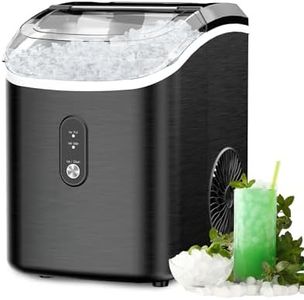We Use CookiesWe use cookies to enhance the security, performance,
functionality and for analytical and promotional activities. By continuing to browse this site you
are agreeing to our privacy policy
10 Best Commercial Ice Makers
From leading brands and best sellers available on the web.By clicking on a link to a third party's website, log data is shared with that third party.
Buying Guide for the Best Commercial Ice Makers
When shopping for a commercial ice maker, it's important to understand your needs and the demands of your business or establishment. Commercial ice makers come in various types, sizes, and with different features, so assessing how much ice you need daily, the kind of ice you require (like cubes, flakes, or nuggets), and your available installation space are all crucial. Matching the machine's capabilities to your specific operation—whether it's a bar, restaurant, hospital, or convenience store—will ensure efficiency, reliability, and customer satisfaction. Remember to also consider cleaning and maintenance, as hygiene is particularly important for any food- or drink-related equipment.Production CapacityProduction capacity refers to the amount of ice a machine can produce in a 24-hour period and is usually measured in pounds or kilograms. This is important because you need to ensure the machine meets your daily ice requirements. Lower-capacity machines (often under 100 lbs per day) are a fit for small cafés and offices, medium (100–300 lbs per day) works well for busy restaurants or bars, and high-capacity machines (over 300 lbs per day) are necessary for large venues or hotels. To pick the right one, consider your peak usage periods and account for future growth when estimating how much ice you’ll need each day.
Ice TypeThe type of ice a machine produces can be cubes, flakes, nuggets, or gourmet shapes. This matters because different types work better for different applications: cubes are best for drinks in bars or restaurants, flakes are ideal for salad bars or medical use, nuggets are popular in healthcare or for blended drinks, and gourmet ice is often used in higher-end establishments. Consider the main use for your ice—serving drinks, displaying food, or medical applications—to choose the type that suits you best.
Storage CapacityStorage capacity is the amount of ice the maker can hold at any one time. While production is how much ice it can make in a day, storage is how much it holds ready to serve. Smaller bins (under 50 lbs) are sufficient for setups where ice is used up quickly or replenished often, while larger bins (over 100 lbs) are suitable for situations where access to fresh ice needs to be nearly constant. Think about how often you’ll be removing ice from the bin and if you experience busy rushes when a large backup is helpful.
Size and PlacementThe size of the machine and where you’ll place it are crucial, as commercial ice makers can be quite bulky. Measure your available space, including width, depth, and height, and consider ventilation needs—some machines require side or back clearance to operate safely. There are under-counter, countertop, and modular models. Under-counter is good for tight spaces or bar areas, modular heads sit atop separate storage bins for large volume, and countertop units are compact for self-service. Base your choice on your physical space and workflow.
Cooling MechanismCommercial ice makers use either air-cooled, water-cooled, or remote-cooled systems. Air-cooled machines are most popular because they’re easier and cheaper to install, but they need more ventilation and can add heat to the room. Water-cooled versions are quieter and work well where temperatures are high, but they use more water. Remote-cooled systems keep heat and noise out of the immediate area by placing the compressor elsewhere. Your best choice depends on your environment: choose air-cooled for well-ventilated rooms, water-cooled if you can handle the extra water use, and remote-cooled for quiet, heat-sensitive spaces.
Ease of Cleaning and MaintenanceCertain machines are designed for easy cleaning, with features like removable parts and cleaning cycles. This is crucial in commercial environments to ensure hygiene and prevent buildup that can affect ice quality. Some machines offer antimicrobial linings or alert you when cleaning is needed. Look for a model that will allow staff to clean thoroughly and regularly. Prioritize this spec if your business is food-service based or must meet strict health standards.

















